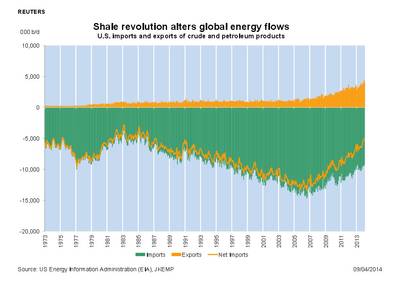Shale Revolution Reverses Global Energy Flow
The United States has replaced OPEC as the marginal petroleum supplier to the world thanks to the shale revolution and improvements in automotive fuel efficiency.
Net U.S. imports of crude and products have halved over the last five years, or by an amount equivalent to the entire daily crude exports of Saudi Arabia.
Net imports totalled 5.2 million barrels per day at the start of 2014, down from 11.2 million at the beginning of 2009, according to the U.S. Energy Information Administration (EIA).
Not one barrel of U.S. shale oil has been sent overseas (except small quantities to Canada) because of the long-standing ban on crude petroleum exports.
But increased U.S. production is still playing a role on global markets via a reduction in its crude imports and increased exports of refined products such as gasoline and especially diesel.
U.S. refiners and traders are successfully arbitraging around the ban by replacing imports of foreign crude with cheaper domestic oil and turning domestic crude that cannot be exported into refined products that can.
Total imports of crude and products shrank to an average of 9.8 million barrels per day in 2013 from a peak of 13.7 million in 2005.
Over the same period, product exports climbed to 3.6 million barrels per day from 1.1 million. Diesel exports doubled, while exports of gasoline, liquefied petroleum gas (LPG) and petroleum coke all recorded big increases.
Reversed Flows
The big three suppliers of crude to the United States - Canada, Mexico and Saudi Arabia - all maintained their sales volumes, according to a recent briefing paper published by the EIA ("U.S. crude oil imports fall but share of top three suppliers highest in four decades" Apr 4).
But imports from other countries in the Middle East, West Africa and Latin America have been squeezed hard, forcing them to turn to alternative markets in Asia.
And on the products side, the United States has sharply cut gasoline imports from Europe and emerged as a major diesel and LPG supplier to countries in Latin America and further afield.
The North American energy revolution and rapid industrialisation in Asia have effectively reversed the flow of energy round the globe. For most of the 20th century, the primary flow was from East to West. Now the main flow is from West to East.
Secure Supplies
The shale revolution has also shifted the marginal source of supply from the Middle East, Africa and Latin America, where investment and production are tightly controlled by governments, to Texas, Oklahoma, North Dakota and other states, where production is driven by the private sector.
Not since the mid-1980s, when new oil fields came onstream in the North Sea, Alaska and the Soviet Union, have world oil supplies been so diversified.
With diversification comes greater security. Global oil markets have weathered the loss of millions of barrels per day from Libya, Syria, South Sudan and Iran over the last three years with almost no impact on prices or the availability of crude.
New Era of Shale
Some analysts question whether the gains in U.S. shale output can be sustained or replicated in other countries, where the conditions both above and below ground are very different.
The hunt for shale opportunities in the rest of the world to match the quality of U.S. plays has so far proved disappointing, according to the head of exploration at Norway's Statoil (STO) .
But the shale revolution is just beginning. By coupling hydraulic fracturing and horizontal drilling with better use of seismic surveys, U.S. shale producers are cutting costs and focusing their drilling programmes more efficiently. Well productivity is still rising.
In the rest of the world, development continues to be hampered by lack of specialist crews and equipment, opposition from environmental campaigners, and the absence of the small entrepreneurial oil producers and private mineral rights that underpinned the North American shale boom.
Each of the barriers is in fact an opportunity to drive significant production if it can be overcome. The potential is enormous. Shale technology is becoming more mature. Skills are beginning to diffuse. And the financial incentive is strong.
Shale's transformative impact in the United States is already exerting a strong pull on policymakers and production companies elsewhere. New shale developments seem likely to emerge in China, Ukraine, South Africa, the United Kingdom, Argentina and other countries by the end of the decade, provided oil prices remain above $100 per barrel.
Advances in production technology are remaking the world petroleum market. If the four decades between the 1970s and the 2000s were the era of the Middle East and OPEC, the next two decades will be the era of North America and shale.
(By Reuters columnist John Kemp; The views expressed are his own. Editing by Jane Baird)











